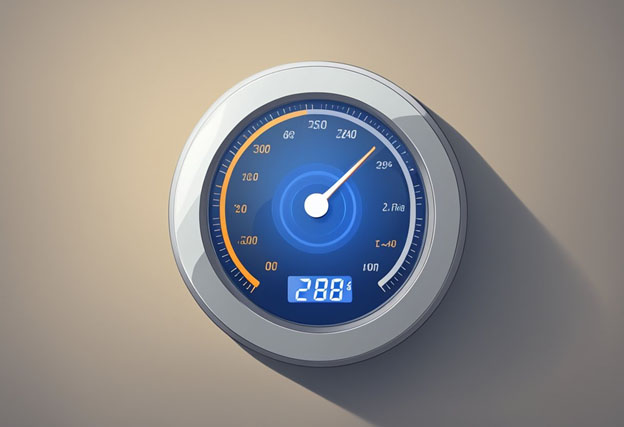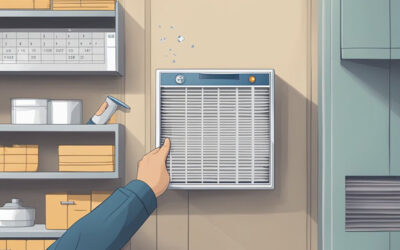The temperature setting on a thermostat is a common topic of debate among homeowners. Some believe that lowering the temperature will cool their home faster, while others believe that it doesn’t make a difference. However, recent studies have shown that the thermostat temperature myth is just that – a myth.
Lowering the temperature on a thermostat does not necessarily mean that a home will cool faster. In fact, the opposite can be true. When the temperature is set lower than necessary, the air conditioning system will run longer and harder, which can actually result in a higher energy bill. Additionally, constantly adjusting the temperature can cause unnecessary wear and tear on the system, leading to costly repairs and replacements.
So why do so many people believe in the thermostat temperature myth? It could be due to a lack of understanding about how air conditioning systems work. Many homeowners assume that the system will work harder and faster if the temperature is set lower, but in reality, it’s more about finding the right balance between comfort and energy efficiency. By debunking this myth, homeowners can make informed decisions about their thermostat settings and save money on their energy bills.
Understanding the Thermostat
How Thermostats Work
Thermostats are devices that control the temperature of a room or building by turning heating or cooling systems on and off. They work by measuring the temperature of the surrounding air and comparing it to a set temperature. If the actual temperature is higher than the set temperature, the thermostat will turn on the cooling system, and if it’s lower, it will turn on the heating system.
Most thermostats use a bimetallic strip, which is made up of two different metals that expand and contract at different rates when exposed to heat. The strip is connected to a switch that turns the heating or cooling system on and off. When the temperature rises, the strip expands, causing the switch to turn off the heating or cooling system. When the temperature falls, the strip contracts, causing the switch to turn on the system.
Setting vs. Room Temperature
One common misconception about thermostats is that setting the temperature lower will cool the room faster. However, this is not true. The thermostat only controls when the heating or cooling system turns on and off, not how fast it cools or heats the room.
For example, if the set temperature is 75°F and the actual temperature is 80°F, setting the thermostat to 70°F will not cool the room any faster than setting it to 75°F. The cooling system will still take the same amount of time to cool the room to 75°F, regardless of the set temperature.
Factors Affecting Thermostat Efficiency
There are several factors that can affect the efficiency of a thermostat, including its location, insulation, and age.
The location of the thermostat is important because it should be placed in a central location where it can accurately measure the temperature of the room. If it’s placed near a drafty window or a heat source, it may give inaccurate readings and cause the heating or cooling system to turn on unnecessarily.
Insulation is also important because it helps to prevent heat loss or gain, which can affect the temperature of the room and cause the thermostat to turn on the heating or cooling system unnecessarily.
Finally, the age of the thermostat can also affect its efficiency. Older thermostats may not be as accurate as newer models, and they may not have the same features, such as programmable settings, that can help to save energy and improve efficiency.
Debunking the Lower Temperature Myth
The Origin of the Myth
Many people believe that turning down the thermostat to a lower temperature will cool their home faster. This myth has been around for years and is still widely believed today. The origin of this myth is unclear, but it may have started because people assume that a lower temperature will cause the air conditioning unit to work harder and cool the home faster.
Scientific Explanation
However, this is not the case. The truth is that air conditioning units work at a constant rate, regardless of the temperature setting. When you turn down the thermostat, the air conditioning unit will work to achieve that temperature. It will not work any harder or faster to cool the home. In fact, if you set the temperature too low, the air conditioning unit may have to work longer to achieve that temperature, which can actually increase your energy consumption.
Energy Consumption Facts
Setting your thermostat to a lower temperature can also increase your energy consumption and utility bills. According to the U.S. Department of Energy, you can save up to 10% per year on heating and cooling costs by simply turning your thermostat back 7-10°F for 8 hours a day. This means that setting your thermostat to a lower temperature can actually have the opposite effect of what you intended, and can end up costing you more money in the long run.
In summary, the lower temperature myth is just that – a myth. Turning down your thermostat to a lower temperature will not cool your home faster, and can actually increase your energy consumption and utility bills. It is important to set your thermostat to a comfortable temperature and leave it alone, allowing your air conditioning unit to work at a constant rate and maintain a consistent temperature in your home.
Optimal Thermostat Settings
When it comes to setting the thermostat, the goal is to find the perfect balance between comfort and energy efficiency. Here are some optimal thermostat settings to consider:
Seasonal Recommendations
During the summer months, it is recommended to set the thermostat to 78°F when you are at home and 85°F when you are away. This will help you stay comfortable while also saving energy. In the winter, set the thermostat to 68°F when you are at home and 60°F when you are away. This will help you save energy and money on your heating bill.
Energy Saving Tips
There are several energy-saving tips to keep in mind when setting your thermostat. First, avoid setting the temperature too low or too high. Contrary to popular belief, setting the temperature too low will not cool your home faster. In fact, it may cause your air conditioner to work harder and use more energy. Similarly, setting the temperature too high will not warm your home faster and may cause your heater to work harder and use more energy.
Another energy-saving tip is to use a programmable thermostat. This will allow you to set different temperatures for different times of the day. For example, you can set the temperature to be cooler at night when you are sleeping and warmer during the day when you are at home.
Finally, it is important to keep your thermostat clean and free of dust and debris. This will help it function properly and accurately measure the temperature in your home.
By following these optimal thermostat settings and energy-saving tips, you can stay comfortable while also saving energy and money on your utility bills.
Impact of Thermostat Settings
On HVAC Systems
The thermostat settings have a significant impact on HVAC systems. When the thermostat is set to a lower temperature, the air conditioning system runs longer to cool the room to the desired temperature. This extended run time can cause wear and tear on the HVAC system, leading to more frequent repairs and replacements.
On the other hand, setting the thermostat to a higher temperature can reduce the load on the HVAC system, resulting in less wear and tear and fewer repairs. However, it is important to note that setting the thermostat too high can also cause discomfort and may lead to health issues.
On Energy Bills
The impact of thermostat settings on energy bills cannot be ignored. Lowering the thermostat temperature does not always result in faster cooling. In fact, it can lead to higher energy bills. When the air conditioning system runs longer, it consumes more energy, which can result in higher energy bills.
Setting the thermostat to a higher temperature can reduce the energy consumption of the air conditioning system, resulting in lower energy bills. However, it is important to find a balance between comfort and energy savings.
On Environmental Footprint
The impact of thermostat settings on the environment is also significant. The energy consumption of HVAC systems contributes to greenhouse gas emissions, which can have a negative impact on the environment.
Lowering the thermostat temperature can increase the energy consumption of HVAC systems, resulting in higher greenhouse gas emissions. Setting the thermostat to a higher temperature can reduce the energy consumption of HVAC systems, resulting in lower greenhouse gas emissions.
By finding a balance between comfort and energy savings, individuals can reduce their environmental footprint without sacrificing their comfort.
Advanced Thermostat Technology
Smart Thermostats
Smart thermostats are a type of advanced thermostat that uses learning algorithms to adapt to the user’s schedule and preferences. They can learn from the user’s behavior and adjust the temperature accordingly, making it more comfortable and energy-efficient. Smart thermostats can also be controlled remotely through mobile apps, allowing users to adjust the temperature from anywhere.
Learning Features
Learning features are a key component of advanced thermostats. They allow the thermostat to learn the user’s schedule and preferences, and adjust the temperature accordingly. Some thermostats can even detect when the user is away from home and adjust the temperature to save energy. Learning features can help users save money on their energy bills and reduce their carbon footprint.
Remote Temperature Control
Remote temperature control is another feature of advanced thermostats. It allows users to control the temperature of their home from anywhere, using a mobile app or web interface. This feature is particularly useful for people who travel frequently or have irregular schedules. With remote temperature control, users can ensure that their home is comfortable and energy-efficient, no matter where they are.
Overall, advanced thermostat technology has come a long way in recent years. Smart thermostats, learning features, and remote temperature control are just a few examples of the many features available to users today. By using these advanced technologies, users can save money on their energy bills, reduce their carbon footprint, and enjoy a more comfortable home.
Maintaining Your HVAC System
Regular Maintenance Tips
To ensure that your HVAC system is running efficiently, it is important to perform regular maintenance. Here are a few tips to help you maintain your HVAC system:
- Clean or replace air filters regularly. Dirty filters can reduce airflow and cause the system to work harder, which can lead to higher energy bills and potential damage to the system.
- Check and clean the coils. Dirty coils can also reduce airflow and cause the system to work harder. This can lead to higher energy bills and potential damage to the system.
- Check and clean the condensate drain line. A clogged drain line can cause water damage to your home and potentially damage the system.
- Check the thermostat settings. Ensure that the thermostat is set to the correct temperature and mode (heating or cooling) to avoid unnecessary energy consumption.
Troubleshooting Common Issues
Even with regular maintenance, HVAC systems can still experience issues. Here are a few common issues and troubleshooting tips:
- If the system is not producing any air, check the power source and circuit breaker to ensure that the system is receiving power. If the system is receiving power, check the air filter and coils for any blockages.
- If the system is producing warm air instead of cool air, check the thermostat settings to ensure that it is set to cooling mode. If the thermostat is set correctly, check the air filter and coils for any blockages.
- If the system is producing cool air but not enough, check the air filter and coils for any blockages. Additionally, check the ducts for any leaks or blockages that may be reducing airflow.
By following these maintenance tips and troubleshooting common issues, you can help ensure that your HVAC system is running efficiently and effectively.
User Behavior and Temperature Control
Psychological Aspects
When it comes to temperature control, user behavior plays a significant role. Many people tend to believe that turning down the thermostat will cool their homes faster. However, this is not always the case, and it can lead to discomfort and high energy bills.
One of the reasons for this misconception is the psychological aspect of temperature perception. People tend to feel cooler when the air is moving, such as when a fan is on, even if the temperature remains the same. This leads them to believe that turning down the thermostat will cool the home faster, when in reality, it just makes the air feel cooler due to increased air movement.
Another psychological aspect to consider is the placebo effect. When people believe that turning down the thermostat will cool the home faster, they may feel more comfortable even if the temperature remains the same. This can lead to a false sense of energy savings, as they may believe they are using less energy when in reality, they are not.
Comfort vs. Savings
Another factor to consider is the balance between comfort and savings. While it may be tempting to turn down the thermostat in an attempt to save money on energy bills, it can lead to discomfort and even health issues.
For example, if the temperature is too low, it can cause dry skin, respiratory problems, and even hypothermia in extreme cases. Additionally, if the temperature is too low, people may feel the need to use additional energy sources, such as space heaters, to stay warm, negating any potential energy savings.
It is important for users to find a balance between comfort and savings when it comes to temperature control. This can be achieved by setting the thermostat to a comfortable temperature and avoiding drastic changes. Additionally, users can invest in smart thermostats that learn their habits and adjust the temperature accordingly, maximizing both comfort and energy savings.
In conclusion, user behavior plays a significant role in temperature control, and it is important to find a balance between comfort and savings. By understanding the psychological aspects of temperature perception and avoiding drastic changes, users can achieve optimal temperature control and save money on energy bills.





0 Comments